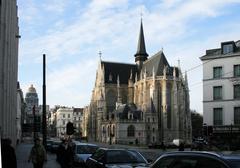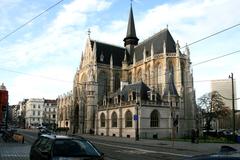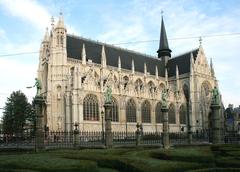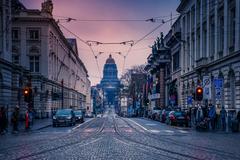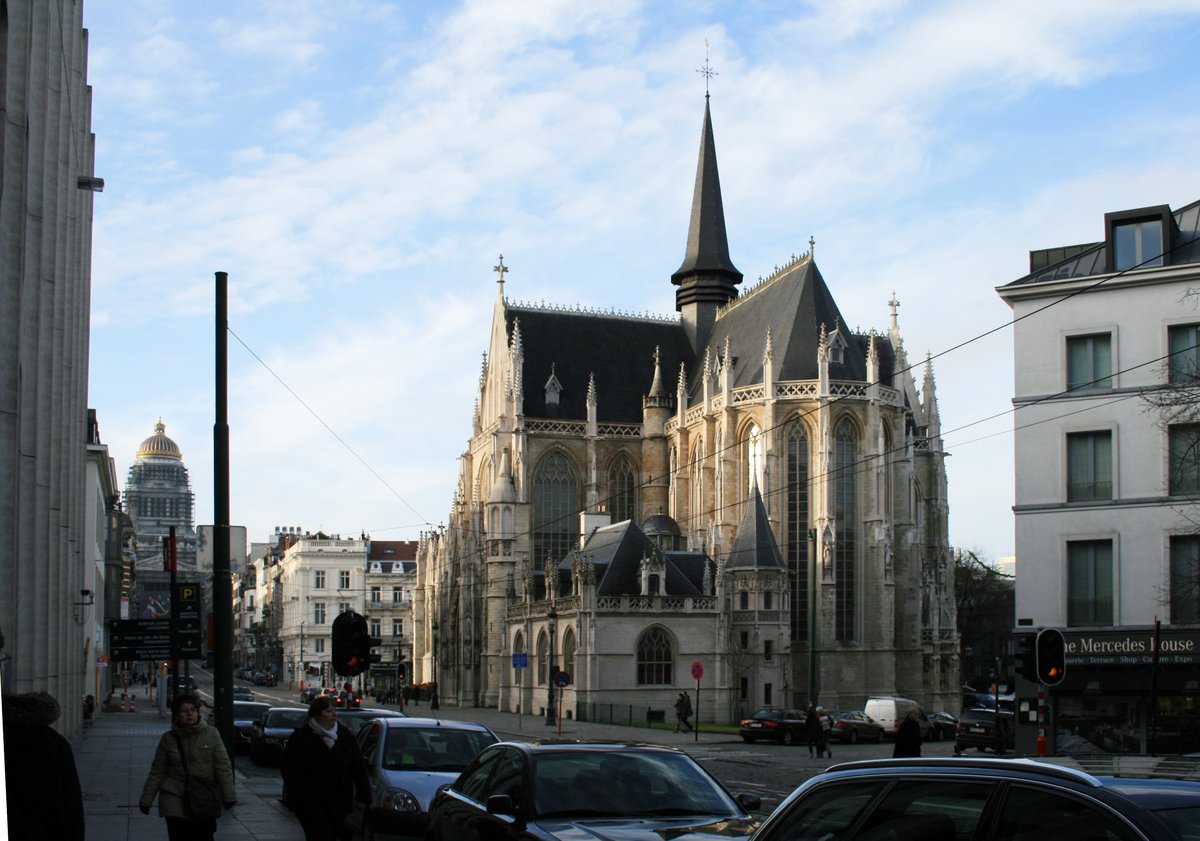
Visiting Our Blessed Lady Of Zavel Church in Brussels: Complete Guide
Date: 14/06/2025
Introduction
Nestled in Brussels’ vibrant Sablon district, the Church of Our Blessed Lady of Zavel (Église Notre-Dame du Sablon / Onze-Lieve-Vrouw ter Zavelkerk) stands as a breathtaking example of Brabantine Gothic architecture and a cherished symbol of the city’s spiritual, artistic, and civic heritage. With origins tracing back to the early 14th century and a remarkable history shaped by guilds, noble patronage, and local devotion, the church offers an inspiring experience for visitors interested in history, architecture, and culture. This guide will help you discover the church’s unique story, architectural wonders, practical visiting information, and insider tips for making the most of your visit (fondsamiseglisesablon.be, visit.brussels).
Table of Contents
- Historical Overview
- Architectural Highlights
- Visitor Information
- Practical Tips for Visitors
- FAQ
- Conclusion and Resources
Historical Overview
Origins and Foundation
The story of Our Blessed Lady of Zavel Church begins around 1304, when the influential Crossbowmen’s Guild established a modest chapel on what was then a sandy hill just outside Brussels’ city walls. This humble structure soon gained prominence after Beatrijs Soetkens, following a vision, brought a miraculous statue of the Virgin Mary from Antwerp in 1348, transforming the site into a pilgrimage destination. The guild and the growing number of devotees pledged to build a grander church, which would become a focal point for Marian devotion and civic identity in Brussels (fondsamiseglisesablon.be, visit.brussels).
Architectural Evolution
Gothic Beginnings
Construction of the current church began in the 15th century, with the nave completed around 1435 and the choir by 1550. Designed in the flamboyant Brabantine Gothic style, the church is characterized by pointed arches, ribbed vaults, flying buttresses, and intricate tracery. The church’s elegant verticality and luminosity are accentuated by its slender columns and vast windows (questoapp.com).
Noble Patronage and Baroque Additions
The 16th and 17th centuries brought sumptuous Baroque chapels, commissioned by the powerful Thurn und Taxis family, reflecting their influence and the church’s aristocratic ties. These chapels, filled with black marble, fine sculpture, and funerary monuments, add layers of artistic richness to the Gothic core.
Restorations
Throughout the 19th and 20th centuries, the church underwent major restoration campaigns, especially after the destruction of earlier stained glass by a hurricane. These efforts, supported by Brussels’ noble families, resulted in the installation of vibrant new stained-glass windows and the preservation of the church’s original Gothic character (fondsamiseglisesablon.be).
Cultural and Religious Significance
The church became the spiritual home not only for the Crossbowmen’s Guild but also for the entire city. The annual Ommegang procession, originating in the 14th century, celebrates the Virgin’s miracle and continues today as a major religious and civic event, connecting medieval tradition with contemporary Brussels life. Royal families, guilds, and local residents have all contributed to the church’s enduring role as a center for worship, music, and community gatherings (fondsamiseglisesablon.be).
Notable Events and Figures
The church’s history is intertwined with European dynasties, especially the Habsburgs and Thurn und Taxis, whose patronage is evident in the art and stained glass. Despite losses during the French Revolution, including the theft of notable sculptures, community resilience and modern restoration efforts have preserved and even recovered many of its treasures.
Architectural Highlights
Exterior Features
The church’s exterior typifies Brabantine Gothic mastery, marked by soaring flying buttresses, pinnacles, decorative gables, and intricate stonework. The main façade, with its ornate portals and statues, makes a dramatic impression and serves as a testament to centuries of devotion and craftsmanship (SmartTravelers).
Interior and Spatial Organization
Inside, visitors are greeted by a luminous nave flanked by aisles with pillars lacking capitals (emphasizing the sense of height). The triforium, choir, side chapels, and vaulted ceilings create an uplifting and harmonious space. The polychrome murals in the choir and a Baroque wooden pulpit from 1697 are standout features (Introducing Brussels).
Stained Glass Windows
The church’s eleven monumental stained-glass windows, primarily 19th-century works by Capronnier and others, fill the church with colorful light. These windows depict Marian scenes, guild history, and biblical episodes, and are especially magnificent on sunny afternoons.
Baroque Chapels
The two Baroque chapels (St. Ursula and St. Marculf), sponsored by the Thurn und Taxis family, are adorned with black marble, gilded altarpieces, and funerary monuments, reflecting the church’s aristocratic connections.
Artistic Treasures
Sculptures by Artus Quellinus the Elder, Jan van Beveren, and Gabriël Grupello, as well as paintings by Michel Coxcie and Abraham Janssens, enrich the church’s interior. The choir’s spandrels feature narrative reliefs described as a “medieval comic strip” (fondsamiseglisesablon.be).
Restoration and Preservation
Restoration efforts have included clearing surrounding residential buildings, installing new stained glass, and comprehensive structural repairs, ensuring the church’s prominence in Brussels’ skyline and its continued use as a place of worship and culture (fondsamiseglisesablon.be).
Visitor Information
Location & Getting There
The church is centrally located between Place du Grand Sablon and Place du Petit Sablon. It’s within walking distance of the Royal Museums of Fine Arts, Magritte Museum, and BELvue Museum (Introducing Brussels).
- Tram: Lines 92, 93 (Petit Sablon stop), 94 nearby
- Metro: Lines 2, 6 (Louise and Porte de Namur)
- Bus: Lines 27, 33, 95, N04–N12 (Petit Sablon stop)
- Parking: BePark – Parking Sablon, Parking Polaert
Opening Hours
- Monday to Friday: 10:00 am – 6:00 pm
- Saturday & Sunday: 9:00 am – 6:00 pm
- Sunday Mass: Church opens at 1:00 pm
- Note: Hours may vary on holidays and during special events. Always check official sources.
Admission & Tickets
- Entry: Free of charge; no tickets or reservations needed.
- Donations: Welcome to support restoration.
Accessibility
- Wheelchair accessible via main entrance ramps.
- Assistance available upon request.
- Some uneven historic surfaces may be present.
Guided Tours & Events
- Guided tours available through Brussels tourism offices and local guides.
- The annual Ommegang procession and regular concerts are highlights.
- Check online event calendars for special exhibitions.
Amenities
- No restrooms or cafés inside the church.
- Numerous cafés, chocolatiers, and antique shops nearby in the Sablon.
Photography
- Personal, non-flash photography is allowed.
- Professional/commercial photography requires permission.
- Please be respectful during services or private prayer.
Practical Tips for Visitors
- Dress Code: Modest attire recommended as it remains an active church.
- Behavior: Maintain a respectful demeanor, especially during Mass or events.
- Language: Signage is in French and Dutch, with some English; basic French or Dutch may be helpful.
- Safety: The Sablon area is safe, but standard tourist precautions apply.
Frequently Asked Questions (FAQ)
Q: What are the church’s visiting hours?
A: Monday to Friday 10:00 am–6:00 pm; Saturday and Sunday 9:00 am–6:00 pm, but Sunday visits begin at 1:00 pm.
Q: Is there an admission fee?
A: No, entry is free. Donations are appreciated.
Q: Are guided tours available?
A: Yes, bookable through local tourism offices and guides.
Q: Is the church accessible for people with disabilities?
A: Yes, with ramps and assistance available.
Q: Can I take photos inside?
A: Yes, personal non-flash photography is allowed.
Q: Are there restroom facilities?
A: No restrooms in the church; nearby cafés have facilities.
Q: What’s the best time to visit?
A: Early afternoons for vibrant stained-glass lighting; mornings and weekdays for fewer crowds.
Conclusion
The Church of Our Blessed Lady of Zavel is not only an architectural gem but a living testament to Brussels’ centuries-old traditions, spiritual vitality, and artistic achievement. From its humble beginnings as a guild chapel to its current role as a beloved city landmark, the church invites you to explore its history, marvel at its artistry, and experience its unique atmosphere. With convenient access, free entry, and a location amid Brussels’ cultural treasures, it is a must-see for any visitor.
Plan your visit with official resources and consider enhancing your experience with guided audio tours through the Audiala app. Explore the Sablon district’s antique shops and cafés, and immerse yourself in Brussels’ historical and cultural tapestry.
References and Further Reading
- Visiting the Church of Our Lady of Victories at the Sablon: Hours, Tickets, and History in Brussels, 2024, Fonds Amis des Églises du Sablon (fondsamiseglisesablon.be)
- Visiting the Church of Our Blessed Lady of the Sablon: History, Architecture & Visitor Information, 2024, Questo App (questoapp.com)
- Visiting Our Blessed Lady of Zavel Church in Brussels: History, Tickets, Hours & Tips, 2024, Visit Brussels (visit.brussels)
- Our Blessed Lady Of Zavel Church Visiting Hours, Tickets, and Visitor Guide to Brussels’ Historical Gem, 2024, Introducing Brussels and SmartTravelers (Introducing Brussels, SmartTravelers)
For an enhanced experience, include high-quality images with descriptive alt tags such as “Our Blessed Lady Of Zavel Church Brussels exterior” and “Stained glass windows inside Our Blessed Lady Of Zavel Church.” An interactive map pinpointing the church and nearby attractions can also be helpful.
